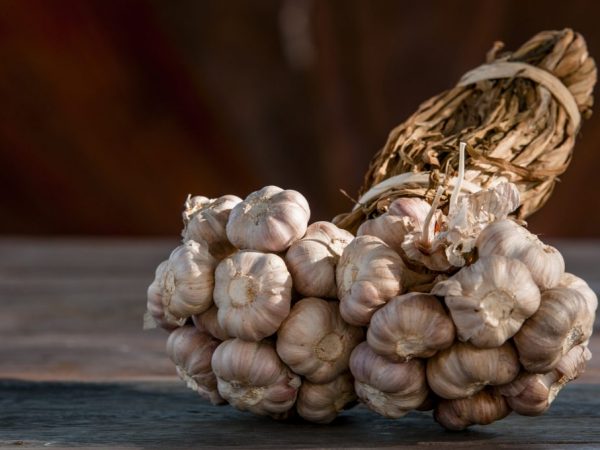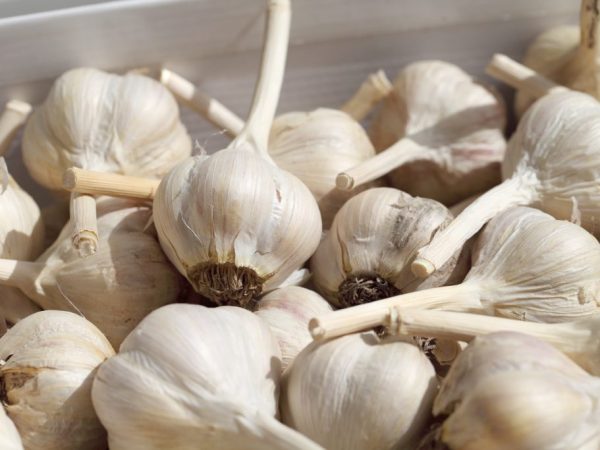What variety of garlic to choose for the Moscow region
Garlic is popular for its taste and antibacterial properties. This crop has many types, the quality of the harvest of which depends on the growing conditions. Garlic varieties for the Moscow region must have good resistance to frost and high humidity.

Garlic variety for the Moscow region
Among the different species, winter varieties are traditionally more suitable for this region. However, you can also pick and spring garlic, guided by the general characteristics of the crop.
Growing in the suburbs
Growing any vegetable crop requires suitable planting conditions. The type of culture is selected according to the climatic characteristics of the region.
Winter garlic for the Moscow region should have good cold resistance, since soil freezing is observed in this region. In turn, the spring species should be selected taking into account the high humidity of the air. At the same time, closer to August, dry weather can be observed in this region, which should also be taken into account.
It is best to use the results of domestic breeding as planting material. As a rule, they are easy to clean. In addition, these species tolerate cold and drought well, unlike their foreign counterparts.
Winter varieties
This subspecies of garlic is characterized by planting before winter, in the last month and a half of autumn. The positive qualities include high productivity and unpretentiousness. However, such garlic has poor keeping quality. As a rule, it is eaten immediately after growing and is rarely bookmarked for the winter. Several winter types are suitable for the Moscow region.
Podmoskovsky
This species has been specially bred for cultivation in temperate climates. Its main characteristics:
- the shape of the bulb is semicircular;
- the head is covered with cream-colored scales with purple veins;
- average weight - 60 g;
- the presence of an arrow.
Moscow garlic is suitable for growing both on private plots and on an industrial scale. Planting should be carried out one month before the soil freezes completely.
One head contains 5 to 7 lobules. The pulp has a strong pungent taste. The amount of harvest is 1.2 kg per 1 m². The shelf life of the crop is 5-6 months.
Gribovsky
This variety is conventionally divided into two subspecies - Gribovsky Jubilee and Gribovsky-60.
Anniversary
Anniversary garlic has the following description:
- head weight - 60 g;
- arrowed view;
- the teeth are covered with a reddish husk with a lilac tint;
- the shape of the lobules is flat-round;
- the taste is pronounced, spicy.

Garlic is different in shape and taste
This species belongs to the early maturing. In one onion, the number of cloves ranges from 7 to 10 pieces. The yield from 1 m² reaches 2 kg. The storage period is 5 months.
Gribovsky-60
The characteristics of Gribovsky-60 are as follows:
- Head weight - 40 g.
- During cultivation, it begins to shoot.
- The slices are covered with scales of a creamy purple hue.
- The shape of the cloves is flat-round.
- The taste is semi-sharp.
The mushroom species is considered mid-season. The number of lobules in the head reaches 12 pieces. The yield from 1 m² usually does not exceed 1.5 kg. Shelf life is 4-5 months. A distinctive feature of this variety is good resistance to bacterial diseases.
Union
This species is the fruit of the work of Russian and Belarusian scientists. Distinctive features of culture are:
- flat head;
- the bulb is covered with a husk of a dark cream shade;
- dense pulp with a semi-sharp taste;
- the average weight of the onion is 45 g.
The union has a powerful leaf structure. One head has 7-9 leaves up to 35 cm long. There are 7 kg of garlic per 1 m². The number of lobules in the head ranges from 5 to 9 pieces. This type of culture is classified as medium late.
This species is popular due to its stable yield and good resistance to many diseases. Also, the Union is unpretentious and tolerates frost well. Shelf life is 4-5 months.
Spring garlic

Spring garlic keeps well
This type of crop gives a good harvest when planted in the spring. Such garlic is not always productive, the number of bulbs is inferior to winter varieties.
However, in this case, spring species differ in the duration of storage. They also tolerate transportation and changing climatic conditions better. There are several varieties of garlic that are suitable for planting in the Moscow region.
Degtyarsky
The name of this variety is associated with the Degtyarskaya selection station. Initially, this species was bred for planting in small areas, but over time, the variety began to be used on an industrial scale. Tar garlic has the following characteristics:
- narrow leaves, the height of which is 40 cm;
- non-shooting view;
- foliage covered with a weak waxy bloom;
- the bulbs are pear-shaped and covered with white scales with a red tint;
- the weight of the head reaches 40 g.
The number of cloves in one onion ranges from 16 to 18. The pulp of the Degtyar species has a semi-sharp taste. The bulbs are considered mid-season.
The yield from 10 m² usually reaches 3 kg. The shelf life of garlic is 7 months.
Moskovsky
This variety was bred for planting in the middle climatic zone. The characteristics of garlic include the following qualities:
- the shape of the bulbs is round and flattened;
- the denticles are covered with white scales with purple veins;
- average head weight - 15 g;
- the leaves of the species reach a height of 30 cm.
The Moscow variety has a mild garlic flavor. The average harvest reaches 2.4 kg 10 m². Reproduction of the species is carried out using denticles.
The culture is classified as mid-season. The storage period is 6-7 months.
Gulliver
This species occupies a leading position among spring varieties. The description of this culture includes the following qualities:
- leaves are covered with a weak waxy bloom and reaches 55 cm in height;
- the variety is arrow-headed;
- the weight of the heads according to official data reaches 120 g, but with proper care you can achieve 250 g;
- the bulbs are covered with gray-white scales.
The number of cloves in one head varies from 3 to 5 lobules. This species is considered to be high yielding and suitable for open cultivation.
A notable feature is Gulliver's resistance to many diseases. The crop storage period is 8 months.
Conclusion
The best varieties for the Moscow region are frost-resistant species. In general, this region is suitable for the cultivation of such a crop. There are many varieties with different flavors that have been bred for cold areas.
Also, these varieties are suitable for both private cultivation and planting for sale. As a result of selection, many of the species have acquired such positive qualities as unpretentiousness and resistance to diseases.


